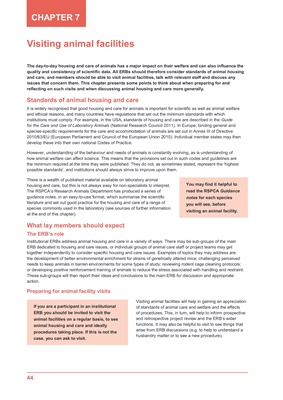
44
Standards of animal housing and care
It is widely recognised that good housing and care for animals is important for scientific as well as animal welfare
and ethical reasons, and many countries have regulations that set out the minimum standards with which
institutions must comply. For example, in the USA, standards of housing and care are described in the Guide
for the Care and Use of Laboratory Animals (National Research Council 2011). In Europe, binding general and
species-specific requirements for the care and accommodation of animals are set out in Annex III of Directive
2010/63/EU (European Parliament and Council of the European Union 2010). Individual member states may then
develop these into their own national Codes of Practice.
However, understanding of the behaviour and needs of animals is constantly evolving, as is understanding of
how animal welfare can affect science. This means that the provisions set out in such codes and guidelines are
the minimum required at the time they were published. They do not, as sometimes stated, represent the "highest
possible standards", and institutions should always strive to improve upon them.
There is a wealth of published material available on laboratory animal
housing and care, but this is not always easy for non-specialists to interpret.
The RSPCA"s Research Animals Department has produced a series of
guidance notes, in an easy-to-use format, which summarise the scientific
literature and set out good practice for the housing and care of a range of
species commonly used in the laboratory (see sources of further information
at the end of this chapter).
What lay members should expect
The ERB"s role
Institutional ERBs address animal housing and care in a variety of ways. There may be sub-groups of the main
ERB dedicated to housing and care issues, or individual groups of animal care staff or project teams may get
together independently to consider specific housing and care issues. Examples of topics they may address are:
the development of better environmental enrichment for strains of genetically altered mice; challenging perceived
needs to keep animals in barren environments for some types of study; reviewing rodent cage cleaning protocols;
or developing positive reinforcement training of animals to reduce the stress associated with handling and restraint.
These sub-groups will then report their ideas and conclusions to the main ERB for discussion and appropriate
action.
Preparing for animal facility visits
Visiting animal facilities will help in gaining an appreciation
of standards of animal care and welfare and the effects
of procedures. This, in turn, will help to inform prospective
and retrospective project review and the ERB"s wider
functions. It may also be helpful to visit to see things that
arise from ERB discussions (e.g. to help to understand a
husbandry matter or to see a new procedure).
CHAPTER 7
Visiting animal facilities
The day-to-day housing and care of animals has a major impact on their welfare and can also influence the
quality and consistency of scientific data. All ERBs should therefore consider standards of animal housing
and care, and members should be able to visit animal facilities, talk with relevant staff and discuss any
issues that concern them. This chapter presents some points to think about when preparing for and
reflecting on such visits and when discussing animal housing and care more generally.
You may find it helpful to
read the RSPCA Guidance
notes for each species
you will see, before
visiting an animal facility.
If you are a participant in an institutional
ERB you should be invited to visit the
animal facilities on a regular basis, to see
animal housing and care and ideally
procedures taking place. If this is not the
case, you can ask to visit.